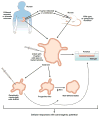Pathobiology of Helicobacter pylori-Induced Gastric Cancer
- PMID: 26385073
- PMCID: PMC4691563
- DOI: 10.1053/j.gastro.2015.09.004
Pathobiology of Helicobacter pylori-Induced Gastric Cancer
Abstract
Colonization of the human stomach by Helicobacter pylori and its role in causing gastric cancer is one of the richest examples of a complex relationship among human cells, microbes, and their environment. It is also a puzzle of enormous medical importance given the incidence and lethality of gastric cancer worldwide. We review recent findings that have changed how we view these relationships and affected the direction of gastric cancer research. For example, recent data have indicated that subtle mismatches between host and microbe genetic traits greatly affect the risk of gastric cancer. The ability of H pylori and its oncoprotein CagA to reprogram epithelial cells and activate properties of stemness show the sophisticated relationship between H pylori and progenitor cells in the gastric mucosa. The observation that cell-associated H pylori can colonize the gastric glands and directly affect precursor and stem cells supports these observations. The ability to mimic these interactions in human gastric organoid cultures as well as animal models will allow investigators to more fully unravel the extent of H pylori control on the renewing gastric epithelium. Finally, our realization that external environmental factors, such as dietary components and essential micronutrients, as well as the gastrointestinal microbiota, can change the balance between H pylori's activity as a commensal or a pathogen has provided direction to studies aimed at defining the full carcinogenic potential of this organism.
Keywords: Gastric Cancer; H pylori; Microbiota; Stem Cells.
Copyright © 2016. Published by Elsevier Inc.
Conflict of interest statement
Figures





References
-
- Parkin DM, Bray F, Ferlay J, et al. Global cancer statistics, 2002. CA Cancer J Clin. 2005;55:74–108. - PubMed
Publication types
MeSH terms
Grants and funding
LinkOut - more resources
Full Text Sources
Other Literature Sources
Medical

